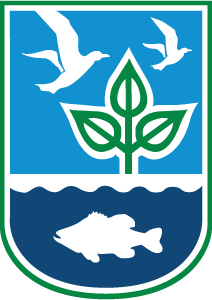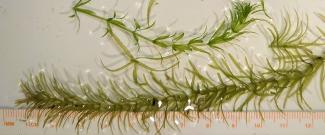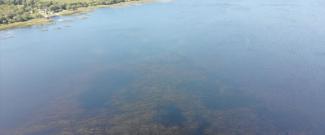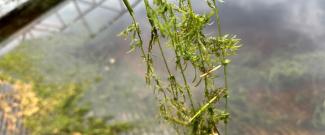Invasive Aquatic Plant: Hydrilla
Impacts of Invasive Hydrilla
Hydrilla is an invasive plant that may be found in freshwater lakes and rivers. This invasive species quickly crowds out native plants with a faster growth rate and several ways to multiply. Its branching stems can expand throughout the water from bottom sediments 25 feet deep. The dense growth quickly changes the structure of habitat for fish, frogs, turtles, aquatic mammals, and waterfowl. Once in a lake, it’s extremely difficult to get rid of, and very costly to control. Hydrilla has been found at a few lakes in Rhode Island, and its spread to other locations must be slowed down as much as possible.
Hydrilla mats grow thick and can become a significant nuisance that affects enjoyment of the outdoors, impeding swimming, boating, and fishing activities. Ruining such recreational activities can, in turn, have economic consequences on local businesses and lakeshore property values, decreasing tax revenues. Thick mats may impede water flow and can lower water quality when they begin to decay.
Hydrilla multiplies easily when the plant stems are chopped into fragments, able to regrow from small pieces only one inch long. These invasive plant fragments may float down rivers to new lakes, or hitch hike on traveling waterfowl, however its spread is accelerated through boating activity. Motor boat propellers cut up the plant quickly, and plant fragments stick to boats, line, trailers and other gear and travel to new locations to become problematic. To prevent the transport of hydrilla, It is important for boaters to check and clear off boats, trailers, and gear after hauling out at a boat ramp and before launching into a different lake. In Rhode Island it is illegal to transport ANY plant part into or out of a waterbody on boats, trailers, cars, or any equipment or gear (see fishing regulations).
Hydrilla in Rhode Island
In August 2023, local residents reported to DEM increasing vegetation at Indian Lake in South Kingstown. DEM staff found hydrilla growing in sparse patches in a few different locations around the lake. Genetic testing of a plant sample confirmed the first documented observation of hydrilla in Rhode Island. Maps of documented locations of hydrilla in Rhode Island are below.
All lakes and ponds in Rhode Island are at high risk for this invasive plant. Due to its severe threat to freshwater ecosystems in Rhode Island, the DEM is keeping a close eye on its further spread. You can help by learning to identify it and reporting any suspected plants to DEM. When invasive plants are identified early (soon after they are introduced), there are better outcomes to helping control their spread.
If you suspect you found invasive hydrilla
RIDEM is trying to track the spread of hydrilla in Rhode Island and encouraging boaters to prevent its spread via boat traffic. The earlier an invasive plant is first observed in a waterbody, the better its chance to be controlled before the problem is too large to manage.
Help prevent hydrilla from getting a head start by learning how to identify the plant, taking a photo of any suspect plants, and reporting photos to DEM for confirmation.
Report Suspected Hydrilla Plant
December 2025 UPDATE:
RIDEM was recently notified that the US Congress has allocated (one-time) $500,000 of federal funding (Congressional Designated Spending) for a grant to RIDEM for chemical treatment to manage hydrilla in Worden Pond. This will require RIDEM to complete a formal federal grant application process; however, the timing of the funding has not yet been announced. RIDEM will apply for the funds with the goal of initiating a treatment in 2026, if feasible, and will work to keep the public updated as we learn more over the winter and make plans for summer 2026.
Additionally, as announced on October 24, 2025, RIDEM received a $250,000 grant from SNEP for lake management to protect RI Watersheds from Invasive Hydrilla. A small portion of this multi-part grant will be used to duplicate the 2024 plant survey of Worden Pond (in June 2026) to better understand the distribution of hydrilla in Worden Pond, as well as fund a boat greeter at the Worden Pond ramp in summer 2026.

Worden Pond is the largest natural (glacial) freshwater pond in Rhode Island, measuring approximately 1,094 acres. Although large, it is extremely shallow, with an average depth of 3 ft, and a maximum depth of about 6 feet. Worden Pond is the headwater of the Pawcatuck River, part of the federally designated Wood-Pawcatuck Wild and Scenic Rivers. The pond serves as spawning and nursery habitat for native anadromous fish species (such as river herring, Atlantic salmon, American shad and alewife) that migrate from the Atlantic Ocean. Worden Pond is heavily used for recreation, including fishing, boating, paddling, and wildlife observation from the state boat launch and accessible dock in South Kingstown.
In November of 2023, RIDEM staff visiting the boat launch observed excessive vegetation washing ashore onto the cement boat ramp and identified the plant as the notorious invasive hydrilla. Worden Pond was only the third lake in Rhode Island where hydrilla had been observed, and RIDEM issued a press release to remind boaters to clean off their boats and gear. Long strands of hydrilla are known to wash ashore in late fall, as part of the plant’s life cycle is to detach itself from the sediment as the hours of sunlight decrease in November. Although that part of the plant begins to die off and decay, small parts of the plant (reproductive structures called tubers and turions) remain in the sediment until warmer weather returns in spring when they germinate to continue the plant’s lifecycle.
Hydrilla is known to many as the “world’s worst aquatic plant” as it has many ways to multiply (including fragmentation), its growth rate is exponential, and it is extremely difficult and costly to manage. Given the severity of the threat of hydrilla to Rhode Island’s largest natural pond and its watershed, RIDEM utilized one-time limited funding from the Narragansett Bay and Watersheds Restoration Fund to hire contractors to complete a thorough plant survey in June of 2024, to understand the extent of the hydrilla infestation, and to evaluate its potential for containment, eradication, or control.
Over the course of three days (June 24-26, 2024), scientists collected data at 475 sites at Worden Pond, collecting information on aquatic plant species presence, percent cover, and sediment type. Three types of aquatic invasive plants were identified, and results were mapped to estimate the number of acres covered by each one. Although it has been known that both invasive variable milfoil and fanwort have been present in Worden Pond for almost fifteen years (first documented in 2009), those plants had only grown to cover approximately 40 acres each. However, the newest invasive in the pond, hydrilla, had quickly spread to cover approximately 149 acres in Worden Pond—over 13% of its total size. Given that the survey was completed in June at the beginning of the growing season, it is likely to have spread to other areas of the pond since that time. The complete report is available below, along with a copy of a presentation summarizing the work that was provided on October 7, 2024, and another presented in South Kingstown on January 24, 2025.
Aerial photos taken by drone flight on September 5, 2024, show hydrilla patches “topped out” where the plant reaches the surface of the water and begins to grow sideways along the surface. The aerial photographs also show crisscrossing lines transecting the areas of hydrilla, likely indicating paths made by motorboats through the vegetation. Boat propellers may chop up the plant, increasing the number of plant fragments in the water. These plant fragments can continue to grow without roots which allows the plant to multiply as the stems continue to reproduce and branch. The plant fragments make hydrilla easy to move downstream via currents and wave action, or to be carried overland by birds, animals, or humans. Therefore, it is essential that boaters prevent the further spread of invasive plants and remember to CLEAN, DRAIN, and DRY all boats, trailers, motors, and gear.
The Town of South Kingstown has applied for and received a 2024 Nonpoint Source Implementation Grant to install a boat cleaning station at the Worden Pond boat ramp, on schedule to be installed in 2025 to help boaters to clean off their trailers, boats and gear before entering, or leaving the pond. Additional signage at the boat ramp will also be posted as part of a grant to the town from the Wood-Pawcatuck Wild and Scenic Rivers.
The first Hydrilla observation was recorded in the state of Rhode Island by RIDEM was at Indian Lake in South Kingstown on August 9, 2023 after concerned residents reported a “weed problem”. Environmental Scientists from RIDEM visited the lake for an initial shoreline survey and identified the presence of the plant by sending a sample out for genetic testing, which confirmed the hydrilla plant (monecious biotype, NOT the same as the Connecticut River strain of Hydrilla). Indian Lake is a 268-acre reservoir, impounded by an earthen dam, and is the headwaters of the Saugatucket River in South Kingstown. Its outlet stream, Fresh Meadow Brook, runs approximately 1 mile to the Saugatucket River, which runs approximately 1.5 miles to the next impoundment, Saugatucket Pond (46 acres). The Saugatucket River Watershed provides habitat for sea-run fish that travel through the Point Judith Pond estuary at the Port of Galilee. Each year, thousands of river herring (alewives) migrate seven miles up the Saugatucket River, passing over three recently reconstructed (2016) and/or updated (2018) fishways to access their historic spawning grounds in Indian Lake. The clear waters of Indian Lake provide open habitat that is essential to the lifecycle of river herring, listed as a “species of concern” by the National Marine Fisheries Service. River herring play a major role as forage fish in sustaining important regional sport and commercial fisheries (striped bass and bluefish) in our region of the north Atlantic. The Nature Conservancy estimates that the Saugatucket River watershed has the potential to support 200,000 spawning adult river herring. Additionally, Indian Lake is also a popular spot for bass fishing tournaments, hosting over a dozen derbies each summer at the state boat ramp, which is open to the public. Waterfront residents also enjoy swimming from their docks, small boat sailing, paddle sports, and angling.
Given the severe threat hydrilla directly poses to the sensitive habitats and recreational uses of Indian Lake, as well as the indirect risk that the plant could spread to other lakes and ponds in the state, RIDEM pursued a national grant for states from a pilot Rapid Response program at U.S. Fish and Wildlife Service to respond to the new invader.
RIDEM was awarded the U.S. Fish and Wildlife Service grant in spring of 2024, and contracted with a licensed herbicide applicator to treat the hydrilla using an EPA-registered herbicide, fluridone, during the summer of 2024. Fluridone is a slow-acting systemic herbicide that has been used to successfully eradicate hydrilla in California, and often used in the northeast to manage the invasive. Hydrilla is most successfully eradicated after four years of successive treatments to ensure reproductive structures rooted in the sediment (hydrilla tubers and turions) are completely eliminated. Subsequently, the Town of South Kingstown applied to RIDEM and received a Narragansett Bay and Watershed Restoration Fund (BWRF) Grant to complete Year 2 (2025) & Year 3 (2026) of the fluridone treatment. After the 2024 herbicide treatment, contractors completed a thorough plant survey at Indian Lake to assess the success of the rapid response control efforts. Scientists found no evidence of any remaining hydrilla plants, and the final report can be found here:
Spread the word, not the plant! Find ways you can help.
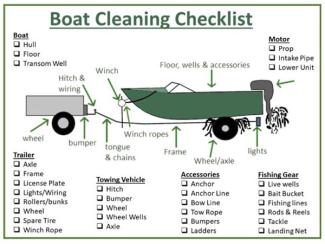
Tips for Boaters and Paddlers:
Paddlers, anglers, and boaters can help slow the spread of hydrilla to other waterbodies by checking their gear, cleaning plants off, draining water from the boat, and allowing them to dry after each use.
Signs are posted at boat ramps reminding boaters to:
-
CLEAN: Remove all visible aquatic plants, animals, and mud from all equipment before leaving water access.
-
DRAIN: Remove water from motor, bilge, livewells, and other water containers before leaving the access point.
-
DRY: Allow boat and gear to dry in the sun for at least 24 hours OR wipe with a towel before reuse.
-
DISPOSE: Put unwanted bait, worms, plants, and fish parts in the trash or compost away from water.
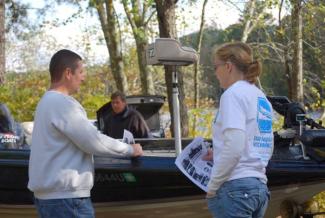
Share the Clean, Drain, Dry Message:
Public awareness of this invasive plant is key to protecting lakes and ponds! The more people who know and use the CLEAN DRAIN DRY approach, the better chance to slow the spread of hydrilla and other invasive species. Please share this information with your friends and family. You can visit stopaquatichitchikers.org to download additional free social media materials to post online and help spread the word. You can use the materials to post a campaign! Mark your calendar for National Invasive Species Awareness Week, which annually occurs in February.
Become a GREAT Boater Volunteer:
The Rhode Island GREAT Boaters Program is an effort to staff boat ramps with volunteers to greet boaters and prevent the transport of invasive species by boats, trailers, and equipment. The volunteer handbook provides guidance for Boat Greeters on interacting with GREAT boaters, educating people about invasives, and conducting boat checks to remove plants. If you are interested in volunteering at a boat ramp, please sign up to receive email alerts about trainings:
Subscribe to the Lakes Management Volunteer List
- Cornell Cooperative Extension’s About Hydrilla
- Army Corp’s Connecticut River Hydrilla
- USDA’s National Invasive Species Information Center
- USGS Non-indigenous Aquatic Species
- Center for Aquatic and Invasive Plants
- Stop Aquatic Hitchhikers Hydrilla
- Kuffner, Alex. "This invasive weed can grow 16 feet a day, and it's clogging RI lakes and ponds." Providence Journal, 16 July 2024
